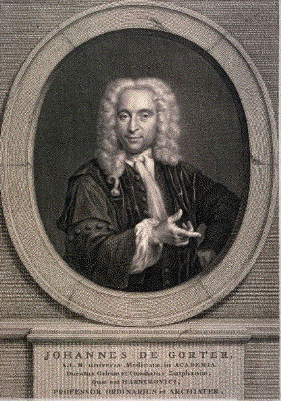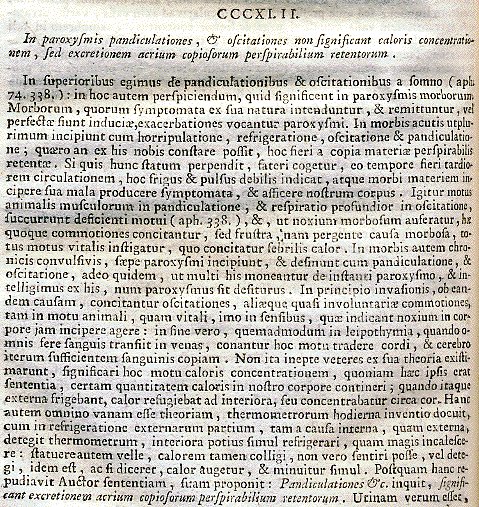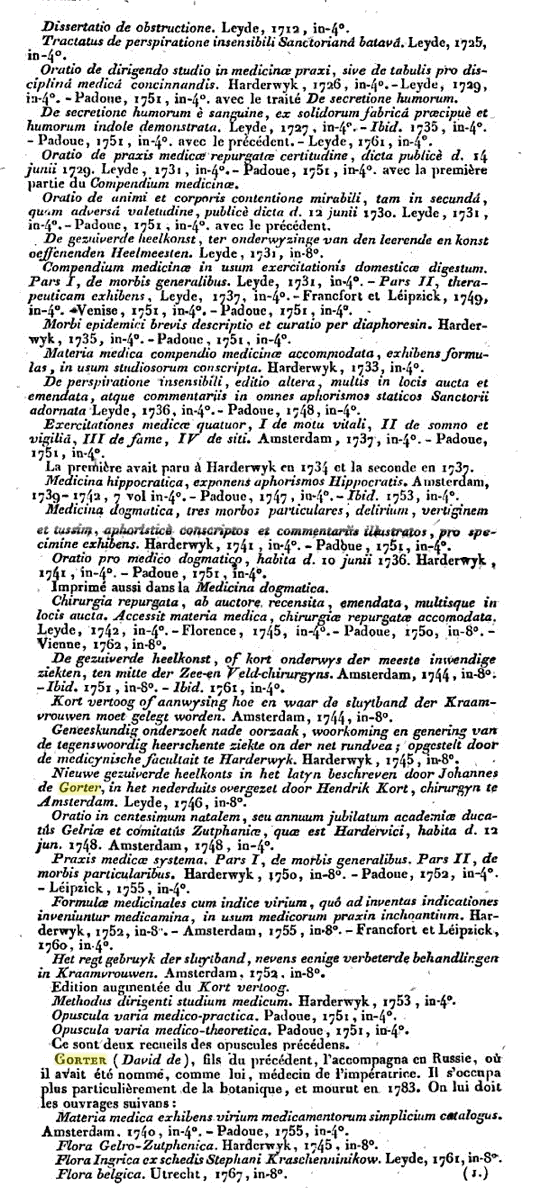 -
- Joannes de Gorter nait le 19 février
1689 en Frise Orientale à Enckuysen
(Hollande). Il part étudier la
médecine à Leyden sous la
direction de Govard Bidloo (1649-1713), Frederik
Dekker (1648-1720) et surtout de Herman
Boerhaave (1668-1738) en compagnie de
Bernhard Albinus (1697-1770). Après avoir
soutenu sa thèse en 1712, il retrourne
exercer dans sa ville natale jusqu'en 1725,
époque où l'Université de
Harderwijk lui offre la chaire devenue vacante
après le décès de
Barthélemy de Moor. Il y enseigne pendant
29 ans. L'éclat de sa renommée le
fait appeler par Elisabeth, impératrice
de Russie qui lui confère le titre de
premier médecin de la cour. Il quitte St
Pétersburg après 4 ans, en 1758,
suite au décès de son
épouse. Il meurt le 11 septembre 1762 en
Hollande.
-
 -
- En 1901 dans sa thèse René
Trautmann écrit :
-
- Gorter, en 1736, dans son livre De
perspiratione insensibili parle longuement du
bâillement; il lui donne pour cause
un besoin de circulation plus rapide du sang et
une anémie de l'encéphale:
«Qua actione sanguis in venis, per
musculos currentibus, magis urgetur versus
venas; inde ad cor hoc tempore major sanguinis
copia ducitur, atque ita deinceps, copiosor
derivatio sanguinis ad cerebrum cerebellumque
pro spirituum secretione. In quibus hominibus
tardior sanguinis versus cerebrum fluxus,
frequens solit fieri oscitatio et pandiculatio,
uti in somnolentia, otio, et initio vigiliarum
ad discutiendurn somnum.»
-
- Plus loin, il classe les
bâillements en bons et mauvais,
selon les circonstances dans lesquelles ils se
produisent: «Quod oscitatio et
pandiculatio in evigilantibus bonum signum, in
principio febris aliisque rnorbis malum signum,
observetur, attentionem meretur. ln animalibus
evigilantibus oscitationemet pandiculationem
rustici inter perfectae sanitatis signa ponunt,
ex quorum absentia existimant quadrupedes
aegrotare. Verum multi morbis curn pandicu
atione et oscitatione paroxysmum incohant:
lipothymia, aliique morbi ex tardiore
circulatione nati, cum his definunt. Quae,
causae bonae sunt circulationem retardantes, uti
somnus naturalis, his bonum signum praebent
oscitationes et pandiculationes; quae vero
causae malae sunt, ut est tardior circulatio in
initio paroxymi febrilis et convulsionis, vel in
vigiliis, oscitatio frequens, quando non expedit
tardam esse circulationem. idem hoc phaenomenon
malum portendit signum».
-
- Bien qu'il admette la production du
bâillement comme moyen de venir en
aide à la circulation entravée,
Gorter pense cependant qu'il arrive lorsque les
«humores» sont accumulées dans
l'organisme; peut-être aussi est-ce, pour
lui, de cette accumulation que résulte
une circulation défectueuse. Quoi qu'il
en soit, dans ses commentaires d'Hippocrate,
il dit pour expliquer l'aphorisme
LVI du livre VII : Anxieatem... oscitationem
vinum, par pari aqua potum solvit morbum:
«0scitatio fit dum homo instigatur ut
valide et lente aperiat os, hauriatque aerem
copiosiorem pulmonibus, utactione ea, lentius
moti humores constrictione musculorum os
aperientium, atque majore pulmoni dilatatione
per rnusculos motus animalis propellantur, quod
in lethargicis somnolentis, principio febrium et
ventriculi impletione est frequens; qui etiam
evigilant, hac actione oscitendi propellunt
lente a somno progredientes
humores.»
-
- Puis il explique ainsi la conclusion du
maitre : «Si stagnantes in ventrioculo
humores in spontaneam faciant, hujusmodi
oscitationes egregie minuuntur tali poto vino
diluto, quo simul ventriculi motus blande
instigatur; sed inde non sequitur
omnemoscilationes hac potione
curari».
-
-
  -
- DE GORTER AND THE
CLASSIFICATION OF DISEASE
- The medical enlightenment of the eighteenth
century
- A. Cunningham & R French
- Cambridge University Press 1990; p
99-102.
-
- First I want to look at a figure who is less
well known and who also came to construct a kind
of nosology. This is Johannes de Gorter, the
ordinary professor of medicine at Harderwijk.
His inaugural oration, given in June 1726, is an
attempt to overcome what he sees as the neglect
of medical practice. Disappointed that the
theoretical medicine of the schools, so subject
to hypothesis and novelty, had not properly
prepared him for practice, he here advocates a
better system, based on arranging and indexing
medical aphorisms for ready use in practice. De
Gorter compares the state of practical medicine
as a discipline unfavourably with that of
botany, and proceeds to improve the former by
means of the latter; that is, he adopts an ideal
of botanical classification in arranging his
aphorisms. Aphorisms, terse and irrefutable,
will make the practice of medicine, he says,
certain and stable, just as the characteristics
of plants have been used in botany.
Classification by general classes and species
allows the botanist to identify plants quickly
by their taxonomic characteristics, and to fit
newly discovered species into the framework: so
should the physician readily be able to
recognise the disease from the features of the
aphorism, and to fit new aphorisms, derived from
experience, into their proper place, that is,
where they are related to their neighbours in
the classification.
-
- The first step in the proposed system was to
be to write down all aphorisms that dealt with
cause, effects, symptoms, predictions or method
of cure. This would compose a 'nursery' or sylva
(the model is no doubt Bacon's) in which each
'plant' is set down with no preconceived
hypothesis, but as observed. Each of them is
then numbered for easy reference. Then by means
of an index, related aphorisms could be grouped
into genera. Finally tables were to be
constructed listing the classes and species
within the genera. The purpose was to construct
a cumulative body of information: the operator
of the system was advised to underline in each
observation, or aphorism, all important words,
which were to go into the index. This was so
arranged that additions could be made in
alphabetical order. As the system grew so the
coverage became more comprehensive: a genus (in
the first table) might be for example 'pain',
which was to have six classes - location, type,
causes, symptoms, methods of cure and change.
Class one might be 'chest', which then in table
two breaks down into species, like ribpain or
clavicle-pain.
-
- We can learn a little more from de Gorter
about eighteenth-century attempts to classify
disease. As we see in Martin's chapter on
Sauvages
in this volume, some inspiration for the
attempts came from Bacon,
and more from the botanists. Five years or so
before Sauvages was classifying diseases on the
model of the botanist Joseph
Pitton de Tournefort, de Gorter was using a
botanical method that brought him into contact
with Linnaeus,
at whose graduation (in 1735) in Harderwijk de
Gorter acted as sponsor; at that time de
Gorter's son David joined Linnaeus on botanising
expeditions.
-
- Twenty-four years after his inaugural
dissertation de Gorter was ready to put his
observations and reading to the test of his
system. But it had changed in the interval. It
was no longer a classification of aphorisms.
Perhaps they have served their purpose and have
turned this System of Medical Practice into a
kind of nosology of disease. Half of it is
concerned with general diseases after the
Boerhaavian
model and the other half is particular diseases,
where the numbered paragraphs approximate to
species of disease and seem to be derived from
the original numbered aphorisms. The basis of
classification is function or location; groups
of diseases are 'titles', not classes. His
modest hope is to open a little window to the
true names of diseases', and the
cross-referencing by which this is achieved also
enables the reader to discover from the listed
symptoms and locations a suitable remedy, even
if he does not know the name of the
disease.
-
- In short de Gorter has used a botanical
technique not so much to classify disease
entities in the way that Sauvages was to do, but
to refine and make more practical the picture of
disease as disordered function. There is one
particular in which, during the course of his
life, he departed from the strict Boerhaavian
model, as others also did. In 1730, four years
after his inaugural oration he gave another, on
the soul in medicine. Unlike Boerhaave
and Hoffmann,
de Gorter said that the soul has 'automatic or
vital' motions in the body, such as that of the
heart and intestines; or it can at least affect
such motions. His devotion to medical practice,
the subject of most of his writing, later
convinced him that there were hidden things in
the body that could not be explained on the
basis of chemistry, mechanics or hydraulics, but
which come from 'distinct laws of life'. He
first formulated what he called General Laws and
had his son David defend them in a thesis in
1731, and later discovered Special Laws. By
reason of these he was obliged to withdraw from
the usual mechanical explanation, qua recedo a
consueta explicatione Mechanica. The critical
case was secretion, where the particles and
pores of the mechanists had replaced the old
faculties. But to de Gorter secretion was
essentially a vital motion, following laws that
were not found in non-living systems. There had
to be, he concluded, an active principle in the
body. Certainly, he said, such things had not
been admitted in discussion until now, but this
was because the chemists and physicists had
succeeded in closing the door and holding up the
progress of knowledge.
-
- This was a personal conversion for de
Gorter, a reaction against the campaign for
mechanism typified if not started by Boerhaave's
oration on the topic. Similar reactions were
recorded by Whytt in
Edinburgh, Sauvages
in Montpellier and Rosetti
in Padua, in the 1730S and 1740s. Rosetti indeed
presents himself as part of a campaign to
reintroduce the Hippocratic principle of
movement, the enormon. This term was also used
by Gaub, whose system of animistic pathology was
partly adopted by Whytt
in lecturing on pathology in Edinburgh in the
1760s. The choice of the term seems a deliberate
one by animists in their campaign against
mechanism. What was common to the animist
alternative was that the lower soul(s) of
seventeenth-century doctrines was abandoned.
Where the passivity of the animal machine made
an energetic soul a necessary part of theory, to
identify that soul (as the animists did) with
the immortal soul of Christian doctrine drew
medicine and religion together in a satisfactory
way. Rosetti identified the Hippocratic enormon
or impetum faciens with the divine breath
breathed into the body of man. It was for
religious rather than physiological reasons that
the soul was held to be perfect: it is not
damaged by disease, said de Gorter, and any
apparent vices - the subject matter of pathology
- came from the body. Gaub and Whytt both
claimed that even in cases of drunkenness it is
the body that is affected, not the soul.
Likewise in therapeutics, medicines act on the
body, not on the soul. Where practice renders
complex motions habitual and almost unconscious,
it is the body, said de Gorter, not the soul,
that becomes used to the actions. In all this
the way in which the body and soul interact
remains unknown, and is attributed directly to
God.
-
- A characteristic of eighteenth-century
animism in the period after Stahl was that the
soul was generally thought to be super-added to
a mechanical body. It was a rigorous use of
mathematics to prove that the machine of the
body could not produce its own motion that
convinced Sauvages and Whytt that there must be
an additional, nonmaterial source of movement.
In contrast the mechanists' arguments were
generally qualitative, not mathematical. They
were statements of faith in a principle, a faith
that de Gorter questioned. A large proportion of
such arguments was concerned with circulation
and the hydraulics of the various fluids and
vessels. Guerrini has pointed out the importance
of secretion for Cheyne,
and we can recall the experiments of Stephen
Hales and the equally well-known calculations of
the force of the heart by Borelli,
Keill and Bernouilli,
together with the hydraulicism of Pitcairne and
the Newtonians, to locate de Gorter's
experiments. He did not deny the laws of
mechanics and hydraulics, but insisted that
vital motions rose above them. The proof was
experimental: attach the cut (upper) end of the
carotid artery of a living dog to a tube of warm
water raised to the height to which the heart
would send the blood, and the water, de Gorter
found, comes down the tube and passes through
the brain. But with a dead dog, not twice the
height forces water through the brain. Nor in
the dead animal can water be compelled to pass
through the kidneys, the liver or the pancreas:
secretion is a vital process.
-

|





